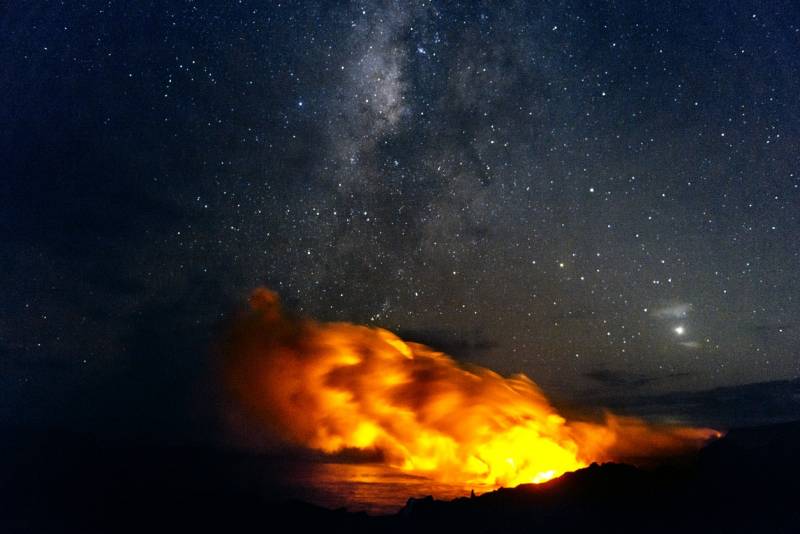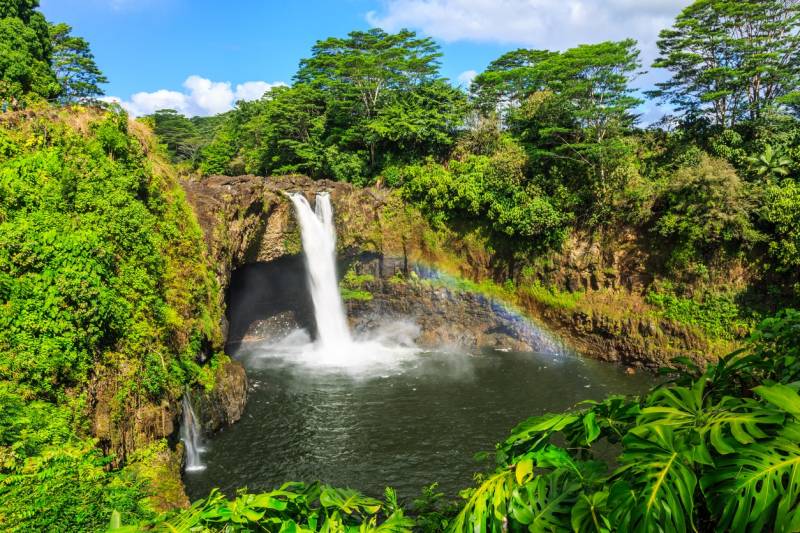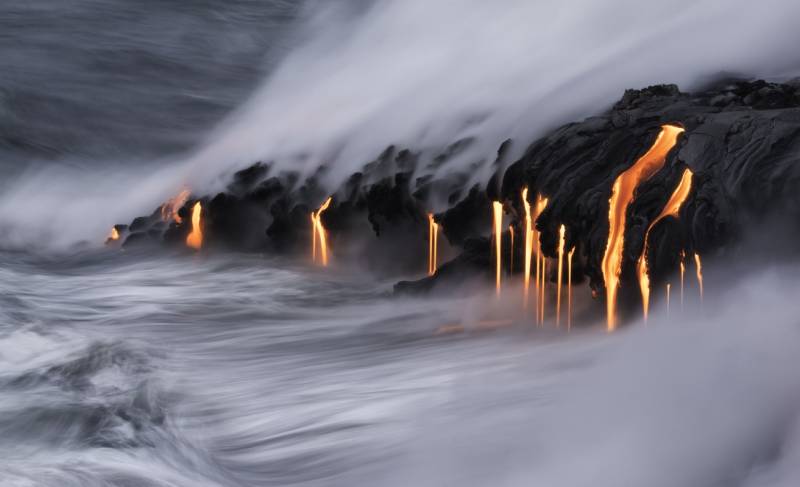The island of Hawaiʻi is the largest of all the Hawaiian Islands, earning its more common moniker – the Big Island. In fact, it’s so large that all the other islands could fit inside it, if you carefully cut them out on a map! With more than 4,000 square miles of diverse paradise to explore, planning a week-long stay means you’ll need to put some forethought into your vacation plans. With so much to see and do, we put together a suggested guide to help you get the most out of your & days on da big rock.
We want to point out that the first step in your planning is to decide whether to stay on the Hilo side or the Kona side. The latter offers far more options for accommodations, as it is home to more hotels and resorts. We also would like to emphasize that some Big Island destinations require some driving. Trust us – they are all well worth it!
Hawaiʻi Island is home to ten of the world’s 14 climate zones, making it a popular destination for adventurous travelers. With tropical rainforests, snow-capped volcanoes, picturesque beaches, waterfalls, and dramatic a
a flows, the Big Island offers so many diverse, rare, and unique experiences. If you have the good fortune of spending an entire week on the Big Island, it’s hard to choose. You may want to put the following sights and activities on your must-see travel itinerary.
Day 1: Chill out
Hawaiʻi is the most geographically isolated place on the planet, and the fact you’ve landed here and are still awake means you deserve a pat on the back — and a tropical cocktail. The security lines and airplane food is behind you, so relax and unwind for your week ahead. Spend the first day of vacation chilling on any one of the island’s pristine beaches with a cold one and leave the stress of real life back at home where it belongs.
If you just can’t wait to get your feet wet, sign up for a snorkel tour of Kealakekua Bay, an underwater marine sanctuary located in South Kona. If you want to really get into the Aloha Spirit on your first evening, check out one of the local Polynesian lūʻau offered at several of Kona’s resorts. The food is ono (delicious) and the entertainment is outstanding.
Day 2: Wake up and smell the coffee

Iced Coffee
South Kona is famous for being one of the best coffee growing regions in the world. It’s likely you’ll wake up early if you’ve arrived from the U.S. Mainland, given the time change. So get ready for some local java and a delicious Hawaiian breakfast. There are several great locations to grab some banana pancakes, or some loco moco — a local breakfast favorite that includes a fried egg, rice, a ground beef patty, and gravy.
Island Lava Java, Splashers Grill, or Huggo’s are three breakfast spots on Aliʻi Drive in Kailua Village that serve up great meals and offer beautiful views of the Pacific Ocean. A stroll through downtown Kailua Village is a great way to ease into your morning. A stop at Huliheʻe Palace is a must for anyone wanting to learn a little about Native Hawaiian history, since it is one of only three royal residents in the state.
After breakfast, take a drive down to the district of South Kona for a tour of Kona Coffee Living History Farm. Costumed interpreters will ‘talk story’ with you and demonstrate what it was like to live in Kona in the early 20th century. Go back even further in time as you head down to Puʻuhonua o Honaunau National Historical Park, also known as the City of Refuge. Learn how ancient Hawaiians lived from park rangers, who will take you on a guided tour.
In the evening, sign up for a night time Manta Ray snorkel tour at one of Manta Village or Manta Heaven. If you prefer to stay dry, Body Glove Cruises offers an award-winning Historical Dinner Cruise. This 3-hour, narrated cruise serves up a delicious meal while you learn all about the history of the Kona coast.
Day 3: Head North
From Kona, drive north on Hwy 19 toward Hwy 250 and Pololū Valley Lookout. Stop in the quaint, artists’ haven of Hawi and browse the eclectic galleries and boutiques. After working up an appetite, grab some lunch at the homey Bamboo Restaurant or indulge in some of the best sushi on the island at Sushi Rock (they have great sake drinks, too).

Pololū Valley Lookout on the Big Island, Hawaii.
Continue driving north until you reach the end of the road at the jaw-dropping Pololū Valley Lookout. It’s a short but steep hike down to the valley and a beautiful black sand beach. Don’t forget your camera for this leg of your journey. If you’ve never had your breath taken away by sheer beauty, that is about to change.
If you still have energy to burn after the gorgeous Pololū Valley hike, explore the paniolo (Hawaiian cowboy) town of Waimea, also called Kamuela. Famous for its vibrant green rolling hills and working cattle ranches, this quaint town is steeped in history. Parker Ranch is the largest cattle ranch in the United States. Pay a visit to the Parker Ranch Museum for a little history lesson before visiting one of the locally renowned restaurants such as Merriman’s, Redwater Café, or Fish & Hog.
Day 4: Cruise the Coastline
Head east from Waimea toward the Hāmākua Coast and take in the magnificent view of Waipiʻo Valley. Located at the end of the Hāmākua Heritage Corridor drive, Waipiʻo is accessible by horseback or guided tour, or you can choose to kick back and enjoy the view from the overlook.

Lava flows and the Milky Way on the Big Island, Hawaii.
Afterward, visit the historic town of Honokaʻa and browse the galleries and local shops. Satisfy your sweet tooth at Tex Drive-In with a freshly baked malasada (Portuguese donut), but save room for lunch because the tiny town if Pa‘auilo is just around the corner and is home to the Hawaiian Vanilla Company. The only vanilla farm in the United States, they serve up creative, vanilla-infused dishes at lunch Monday through Friday and it’s worth every penny. After lunch, you’ll be treated to a tour of the vanilla farm where you’ll learn how the delicate vanilla orchid is grown.
Day 5: Hilo Town
A drive to Hilo will take you past ‘Akaka Falls State Park where you can explore two of Hawai‘i’s most famous waterfalls. Breakfast anyone? Ken’s Pancake House is famous for its huge stacks of pancakes and tasty waffles. Top them off with coconut syrup and get your jitters on with some locally grown coffee before you venture out into Hilo town. Tropical and rainy, you may want to bring an umbrella just in case of an unexpected shower. Hilo Bayfront hosts an array of charming boutiques and galleries to explore, as well as the fascinating Tsunami Museum.

Rainbow Falls, Big Island, Hawaii.
The Hilo farmers’ market is open on Wednesdays and Saturdays and offers local treats, fresh fruits, and yummy bento boxes. You can pick up some picnic items and head to Richardson’s Beach to gaze out at Hilo Bay or take a dip in the ocean. If the skies are clear, drive up Saddle Road to Mauna Kea in the evening for some of the best stargazing in the world. Free of light pollution, the stargazing observatory at the Mauna Kea Visitor Information Station sits at 9,200 feet above sea level. The combination of extreme dark, high altitude, and low humidity make for a spectacular night sky. Free programs are offered after sunset (*4 nights per week, weather permitting) but be sure to bring a jacket (and a scarf and hat – and maybe some gloves, too!) because the temperature drops quickly at this altitude after sunset.
Day 6: Hot, Hot, Hot!
Set the alarm clock for well before sunrise and drive down to Kalapana for a once-in-a-lifetime experience. There are so few places on Earth where you can witness red-hot molten lava. While it’s visible during daylight hours, it’s most dramatic when viewed in the dark. It’s about an 8-mile hike round trip and you’ll want to contact Civil Defense for safety tips. During the day, there’s also the option of renting bikes or taking boat tours to get a different perspective, and possibly watch the lava as it makes new land as it cools in contact with the Pacific Ocean waves.

Lava entering the Pacific Ocean on Kilauea, Big Island, Hawaii.
Other daytime activities in the area – explore the Puna District of Hawaiʻi Island and relax and unwind with a soak in the volcanically heated pools of Ahalanu, or browse the artistic town of Pahoa and grab a bite at Kaleo’s Bar and Grill.
Day 7: Last Day in Paradise
Your last day of vacation is always bittersweet. If you’re still feeling like exploring the Big Island further, drive to the southernmost point in the 50 states at Ka Lae (also known as South Point). At just under 19° N, the area is registered as a National Historic Landmark District. The adventurous can take a dive or a jump into the Pacific Ocean from there. A rugged trek in a 4 x 4 (offered by locals in the area) will take you to a sparkling, emerald green sand beach. This is also for the adventurous since the ride, while short, is quite bumpy and beach access can only be gained after a short hike and a ladder climb down to this protected gem of a spot.

Kekaha Kai Beach
If you’ve had your fill of Big Island adventures, then take the time to really soak in your surroundings back at some of the beautiful Big Island beaches that are close to your accommodations. Relax on the beach and take a deep breath of the plumeria scented ocean air. Soon you’ll be headed back to real life with great memories of your Hawaiian vacation, but for today, you’re still in paradise. Slow down and live Hawaiian style for just one last day.

Leave your opinion here. Please be nice. Your Email address will be kept private, this form is secure and we never spam you.